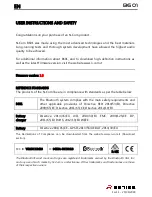
31
4
SAFETY
4.1
INTENDED USE
Both installation and use of the control sensor are subject to the applicable national regulations. Alongside
the operating instructions and the legal regulations applicable in the country and place of use in respect of
accident prevention, the recognised technical regulations for safe and professional work must be ob-
served.
The water being used must comply with the European Drinking Water Directive.
The manufacturer/supplier must be consulted before using water of a different quality or water with addi-
tional additives.
This control sensor is suitable for use in cold drinking water up to a maximum water and ambient temper-
ature of 30 °C (86 °F). It is manufactured according to the state of the art and recognised German safety
regulations.
The control sensor may only be used as described in the operating instructions. Any other use or use be-
yond the specified use is considered to represent incorrect use.
Additional dangers exist in the event of incorrect use and if the danger symbols and safety instructions are
ignored. The manufacturer/supplier shall not be responsible for any resulting damage. All risks are borne
solely by the user.
Intended use includes observance of the operating instructions.
The manufacturer/supplier must be consulted before using the water pump outside the limits of use de-
scribed in these operating instructions. The control sensor must only be used as intended in a technically
fault-free state, while maintaining safety and hazard awareness, and in compliance with the operating in-
structions.
Ensure that malfunctions are rectified immediately!
4.2
MATERIALS USED
The materials used are resistant to the physical, chemical and corrosive loads expected to be encountered
in drinking water and fulfil the specifications given in the test regulation VP 638 (“Leakage detectors for
installation in drinking water systems”). All materials are hygienically and physiologically harmless. Plastics
contacted by drinking water fulfil the KTW Guideline (Guideline for the Hygienic Assessment of Organic
Materials in Contact with Drinking water) of the German Federal Environmental Agency (UBA) and
DVGW (German Technical and Scientific Association for Gas and Water) working sheet W
270. Metallic
materials fulfil the requirements of DIN 50930-6 (Effect of metallic materials on the quality of drinking wa-
ter).
If a control sensor is operated when not installed, there is a risk of crushing due to
rotating parts!
Содержание CLEAR 2.0 SAFE
Страница 12: ...12 6 BETRIEB Abb 5 CLEAR 2 0 SAFE mit abgenommener Abdeckhaube Abb 6 CLEAR 2 0 SAFE Schaltung...
Страница 36: ...36 6 OPERATION Fig 5 CLEAR 2 0 SAFE with removed cover Fig 6 CLEAR 2 0 SAFE switch...
Страница 60: ...60 6 EKSPLOATACJA Rys 5 CLEAR 2 0 SAFE ze zdj t os on Rys 6 CLEAR 2 0 SAFE uk ad elektryczny...
Страница 74: ...74 Notizen Notes Notatki...
Страница 75: ...75 Notizen Notes Notatki...
















































